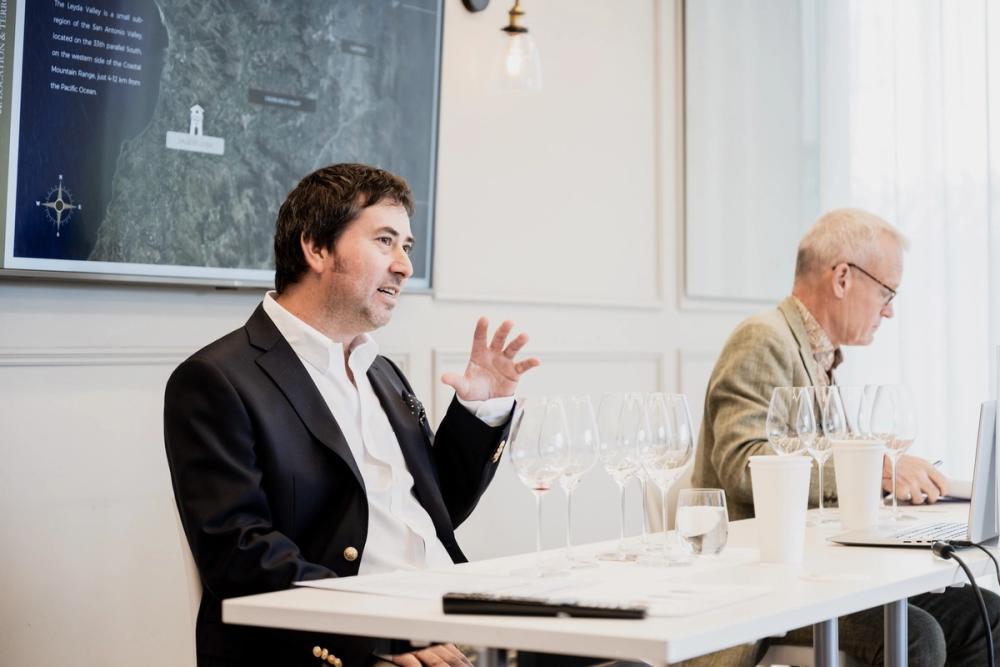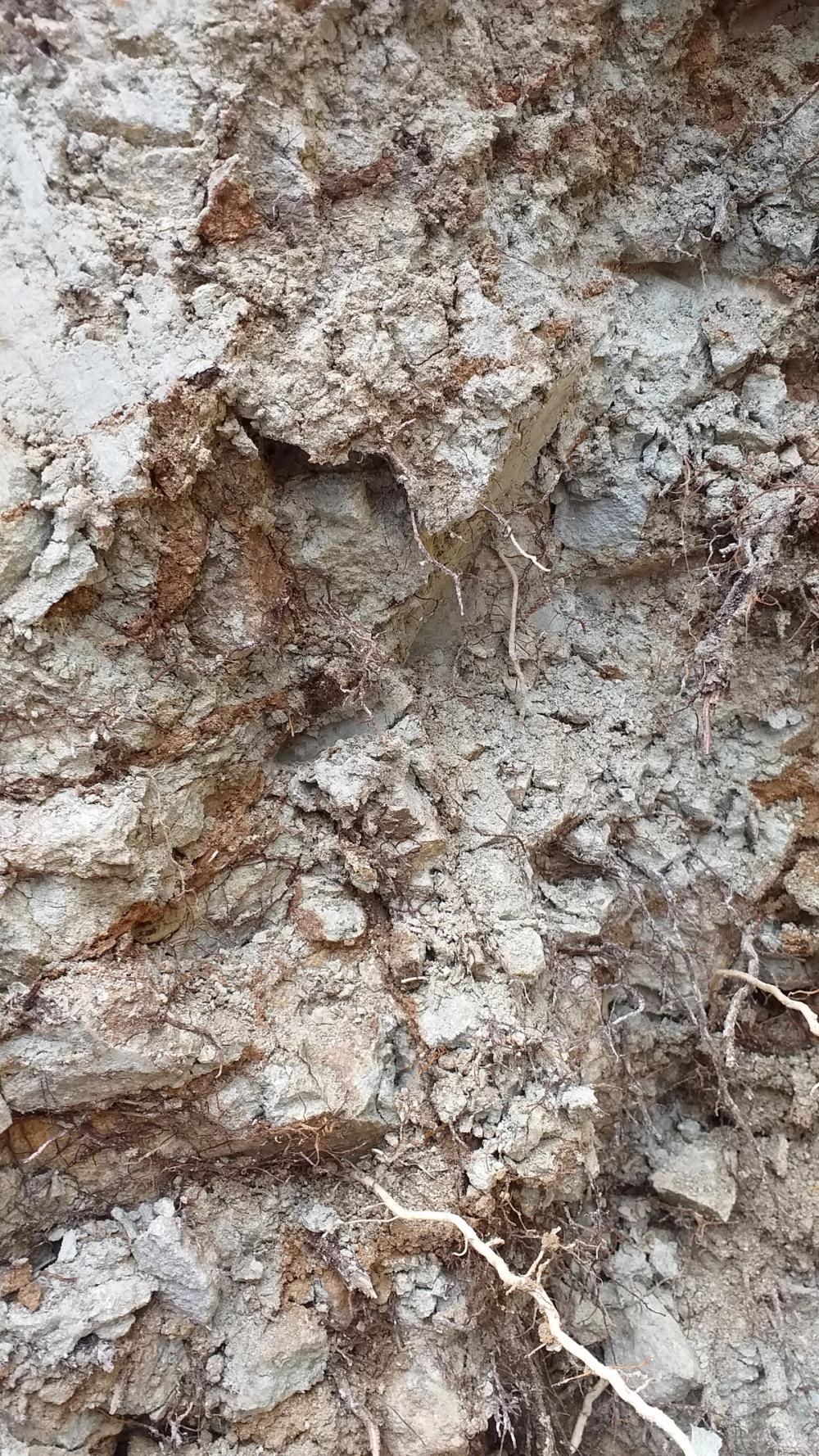The word masterclass is much overused for tutored wine tastings but spending two hours with Tomás Rivera, viticulturist at Viña Leyda, and Tim Atkin MW was one of the most intense educational experiences I’ve had since university. My brain could barely keep up, let alone my pen. It was the next best thing to a press trip to Chile.

Intense: Viña Leyda viticulturist Tomás Rivera and Tim Atkin MW, IMW, September 11, 2024. © Thomas Skovsende Photographer
I knew that Chile was long but hadn’t quite realised how strung-out viticulture was. The distance between the most northerly vineyards and those in the cold distant south is 3795 km - the distance between London and Senegal. Between those extremes there are six main wine regions. It’s therefore very difficult to generalise about viticulture and vintages in Chilean wine.
Coastal areas of Chile are, well, chilly, due to the Humboldt current which carries cold water from the Antarctic up the west coast of South America. According to Rivera, the Pacific coast around the town of San Antonio was thought until recently to be far too cold for viticulture. It’s only 90 km from Santiago but whereas the Central Valley is protected from the 10°C chill of the ocean by a mountain range, the Cordillera de la Costa, the coast bears its full cooling effect.

Like a patchwork quilt: Planting began in 1998 in the two main vineyards El Granito and El Maipen
The vineyards of Leyda, a subregion of the San Antonio valley, which are between 4 and 10 km from the sea, never get much above 23°C. Even at the height of the summer the heat is tempered by fog coming off the water in the morning. Compare that with England where temperatures in Kent and Essex can regularly top 30°C in August.
Leyda, however, never gets extremely chilly either, a low of 8°C in the winter. Overall, it has around 100 days from flowering to harvest, comparable with England. In short, it’s perfect for the slow ripening of cool climate varieties like Pinot Noir. It’s also arid so the disease pressure is less. Irrigation is essential even in the winter so what made Leyda possible as a grape-growing area was the construction of an 8km pipeline bringing water to the region from the Maipo river.

Unique calcareous soil
As well as the climate, what makes Leyda special is the soil, an interesting mixture of granite (very rare in Chile), limestone and clay. Along with the right soil, climate and irrigation, the final piece in the jigsaw was planting the right clones. Previously Pinot Noir in Chile relied on sparkling wine clones and the so-called Concha Y Toro clone which probably came from UC Davis. Now Leyda has clones like 777 which are far more suitable for producing high quality reds. Rootstocks are not needed because for reasons that are not entirely understood phylloxera has never made it over the Andes.
Planting began in 1998 in the two main vineyards El Granito and El Maipen. In addition to Pinot Noir, they planted Sauvignon Blanc, Syrah and Chardonnay. The first vintage was 2001. Originally the company was owned by Gustavo Llona and the Fernandez family but it was bought in 2007 by South American giant San Pedro which owns Viña Tabali and the massive-selling Gato Negro brand.
Right from the start, Leyda was aiming at the premium market. Yields are 40% below Chilean norms so these were always going to be expensive. Leyda was made a DO (denominación de origen) in 2002, so Leyda is both a brand and an appellation – a bit like Château Margaux – and there are now 10 producers in the region.
Rivera pays a minute attention to where each grape comes from, harvesting by small plots called polygons so he can get to know the precise terroir of each part of the vineyard. The winemaker is Viviana Navarrete. The Pinot Noir for Lot 21 undergoes a three-day maceration followed by fermentation with natural yeasts. She’s aiming for a minimum of oak character so ageing takes place in a mixture of foudre, concrete egg and used barrel.

© Thomas Skovsende Photographer
We tasted through four vintages of the Viña Leyda Lot 21 from the 2016 to 2022. There was a clear evolution in styles from the broader 2016 and 2018 to the razor sharp 2020 and the slightly fuller 2022. The latter vintages showing a thrilling purity of fruit and distinct floral character. Until recently Lot 21 was the top Pinot Noir but we were given a sneak preview of a new super premium bottling called Origin which was thrilling. The price is likely to be around three times the price of Lot 21 and only available through restaurants. Very upmarket restaurants.
Tim Atkin commented that “Chile is still finding its way with Pinot” but, from tasting through the Leyda wines, it’s clear that it is rapidly improving. The Lot 21 wines showed the huge potential while Origin demonstrated that the country could produce some of the most exciting Pinot Noir in the world.
While Pinot in Chile is rapidly changing, Atkin thinks that Pinot has changed Chile. Now “people are concentrating on the right site and right varieties” rather than just planting everything in the warmth of the Central Valley. Rivera agreed: “there’s now a separation between cold climate varieties and regions and the warm ones.”
Overall, the country’s vineyard area is shrinking, Rivera mentioned that there is “something of a crisis” in the industry. But he doesn’t think necessarily that’s a bad thing. Producers are moving away from Chile’s warm viticulturist heartland, they’re heading south and west in search of more abundant water and cooler climates which suit grapes like Pinot Noir better. Tasting how good Leyda’s wines are after a little over 20 years, makes me wonder how good they’ll be in another 20. Roll on the 2044 masterclass!
Tasting Leyda Pinot Noir

© Thomas Skovsende Photographer
2016 Leyda Lot 21 Pinot Noir
Made from mainly clay vineyards. 13.5%.
This wasn’t giving away much on the nose, it's a little herbal and leafy.
It feels really tight on the palate, not much fruit, hard. With time it does fill out a bit and there's some spice, texture and a nutty quality. Apparently not a good vintage and I think this is unlikely to improve.
2018 Leyda Lot 21 Pinot Noir
Mainly grapes grow in granite soils. 13.5%
The smell is heady with ripe strawberries, baking spices and a touch of leather.
Fuller than the 2016 with lots of spices and with time dark cherry fruit with leather on the finish. Still quite a bit of tannin. I like this, it's in a bold almost Sonoma Pinot style.
2020 Leyda Lot 21 Pinot Noir
Mainly limestone soils, a very hot vintage so they harvested early hence only 12.5%.
Vivid nose with raspberries and violets
Crunchy fruit on the palate with a full creamy finish.
This is very fresh with, I thought, a stimulating purity to it, though some tasters found it a bit angular. I imagine it would be much better with food.
2022 Leyda Lot 21 Pinot Noir
From mainly limestone soil, 13.5%
Crunchy red fruit on the nose, very alive and pure.
High acidity, some herbal/ floral notes, spicy with grainy tannins and a peppery finish. Vibrant and delicious.
I think this could do with a little more time in bottle and then it will be very good. For most people this was the pick of Lot 21s.
2020 Leyda Pinot Origin
From a 0.8 hectare block on limestone soil, 777 clone, 35% whole bunch. 13.1%
Amazing freshness on the nose, violets, saline, it's like smelling the Pacific ocean.
Grainy tannin, mineral, tightly-coiled and intense, with toasted spice on the finish.
Very young, needs time, but clearly this is an exceptional wine.

Henry Jeffreys at the tasting ©Thomas Skovsende Photographer
The wines of Viña Leyda are imported and sold in the UK through Enotria & Coe which is a commercial partner of The Buyer. To discover more about them click here.
Viña Leyda is owned by VSPT which is also a commercial partner of The Buyer. To discover more about them click here.
































